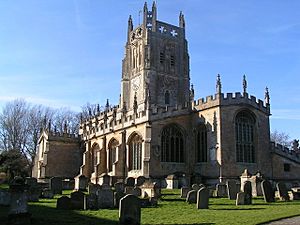Fairford stained glass facts for kids
The Fairford stained glass is a collection of 28 beautiful, very old stained glass windows. You can find them in St Mary's Church, Fairford, in Gloucestershire, England. These windows are super important because they are probably the most complete set of medieval stained glass in all of Britain!
The windows show many scenes from the Bible. They were added after a rich wool merchant named John Tame (who lived from about 1430 to 1500) rebuilt the church. His son, Edward Tame, made sure the glass was created between 1500 and 1517.
Experts believe the windows were made by a talented artist named Barnard Flower. He was a glassmaker for King Henry VII. Some sources also say that John Thornton and Galyon Hone might have helped. The overall design for the windows might have come from Richard Fox, who was a bishop.
There's a fun story about how the windows got to Fairford. A historian named Ralph Bigland shared it. He said that around 1492, a ship was sailing to Rome from the Netherlands. It was full of painted glass. John Tame supposedly captured this ship! He then decided to build a church just to put the glass in.
Most of the 28 windows have four separate tall sections. Each section usually shows a different Bible scene. Above these scenes, there are painted gothic designs. Six smaller lights are at the very top of the arched windows. These often show angels if the scenes below are about faith. They might show devils if the scenes are about bad things.
Contents
How the Windows Survived History
These amazing windows have been around for a very long time. They have survived many big changes and dangers over the centuries.
Surviving the Reformation
The windows survived the Protestant Reformation. This was a time when many images in English churches were destroyed. People changed how they worshipped, and some old church decorations were removed. But the Fairford glass stayed safe.
Escaping the English Civil War
In 1642, during the English Civil War, the windows almost faced destruction. An army called the Roundheads was marching nearby. Soldiers often used churches as temporary stables or barracks. They didn't always care about the church buildings.
Some Roundheads were very strict. They didn't like the old church images, calling them "idolatrous." This meant the stained glass was in danger. But a quick-thinking man named William Oldysworth saved the day! He was in charge of the church's income. He quickly ordered the windows to be taken apart. The glass was hidden before the troops arrived. Because of him, we can still see these beautiful windows today.
It's possible that when the glass was put back after the war, some pieces ended up in the wrong spots.
Protecting the Glass from Damage
In 1725, the windows got extra protection. A "lattice of wire" was added to each window. This cost a lot of money, about £200! A woman named Elizabeth Fermor paid for it. Her family had acquired the land around Fairford in the 1660s.
A few panes were damaged during a big storm in November 1703. They were either fixed or replaced. Later, in 1889-1890, twenty-six windows were repaired and had their lead frames redone.
Safeguarding During World War II
During the Second World War, the stained glass windows were removed again. From 1939 to 1945, they were stored safely in a cellar. This kept them safe from bombs and other wartime dangers.
Modern Restoration Efforts
A big project to clean and fix the windows started in 1988. It finished in 2010. Now, clear glass protects the old stained glass. This helps keep them safe for many more years to come.
Learning More About the Windows
If you want to learn more about the history and pictures in the windows, you can check out these old books:
- Bigland, Ralph, An Account of the Parish of Fairford in the County of Gloucester with a Particular Description of the Stained Glass in the Windows of the Church, Engravings of Ancient Monuments with Inscriptions, etc., etc., London, 1791, pages 6–10
- Neale, John Mason, (ed.) Illustrations of Monumental Brasses, No.VI, Cambridge Camden Society, Cambridge, 1846, pages 115–132


